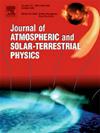A deep learning approach via multifractal detrended fluctuation analysis for PM2.5 prediction
IF 1.8
4区 地球科学
Q3 GEOCHEMISTRY & GEOPHYSICS
Journal of Atmospheric and Solar-Terrestrial Physics
Pub Date : 2025-01-23
DOI:10.1016/j.jastp.2025.106444
引用次数: 0
Abstract
Accurate prediction of PM 2.5 concentrations in Asian regions with air pollution as a hot topic is still considered as a strong premise for the public to take proactive measures for effective control of the adverse effects of PM 2.5. In this study, a hybrid model consisting of convolutional neural network (CNN)-long short-term (LSTM) with multifractal detrended fluctuation analysis (MF-DFA) for air pollution and meteorological time series data was proposed, and it was used to predict the next day's 24-h average PM 2.5 concentration in Beijing City. MF-DFA was employed to identify the fractal characteristics of the measured data series; it has been considered for the historical data of the target monitoring station and, as a result, enabling CNN-LSTM model to adopt valuable input data. CNN of the hybrid model efficiently extracted the inherent features relevant to PM 2.5 in the input data, and LSTM fully conveyed the historical information of the time series data. Air quality and meteorological data from January 1st, 2015 to February 24th, 2018 were adopted. Through the comparison of the performance indices of the proposed model with MLP and LSTM models, the proposed model showed better prediction accuracy. When the integrated data (RMSE 11.732, MAE 5.18, MAPE 0.131) were used as input of the model, it is guaranteed that the performance of the model is improved compared to the cases of using air quality data (RMSE 11.886, MAE 6.17, MAPE 0.272) and meteorological data (RMSE 29.673, MAE 25.171, MAPE 0.425) as input, respectively.
求助全文
约1分钟内获得全文
求助全文
来源期刊

Journal of Atmospheric and Solar-Terrestrial Physics
地学-地球化学与地球物理
CiteScore
4.10
自引率
5.30%
发文量
95
审稿时长
6 months
期刊介绍:
The Journal of Atmospheric and Solar-Terrestrial Physics (JASTP) is an international journal concerned with the inter-disciplinary science of the Earth''s atmospheric and space environment, especially the highly varied and highly variable physical phenomena that occur in this natural laboratory and the processes that couple them.
The journal covers the physical processes operating in the troposphere, stratosphere, mesosphere, thermosphere, ionosphere, magnetosphere, the Sun, interplanetary medium, and heliosphere. Phenomena occurring in other "spheres", solar influences on climate, and supporting laboratory measurements are also considered. The journal deals especially with the coupling between the different regions.
Solar flares, coronal mass ejections, and other energetic events on the Sun create interesting and important perturbations in the near-Earth space environment. The physics of such "space weather" is central to the Journal of Atmospheric and Solar-Terrestrial Physics and the journal welcomes papers that lead in the direction of a predictive understanding of the coupled system. Regarding the upper atmosphere, the subjects of aeronomy, geomagnetism and geoelectricity, auroral phenomena, radio wave propagation, and plasma instabilities, are examples within the broad field of solar-terrestrial physics which emphasise the energy exchange between the solar wind, the magnetospheric and ionospheric plasmas, and the neutral gas. In the lower atmosphere, topics covered range from mesoscale to global scale dynamics, to atmospheric electricity, lightning and its effects, and to anthropogenic changes.
 求助内容:
求助内容: 应助结果提醒方式:
应助结果提醒方式:


